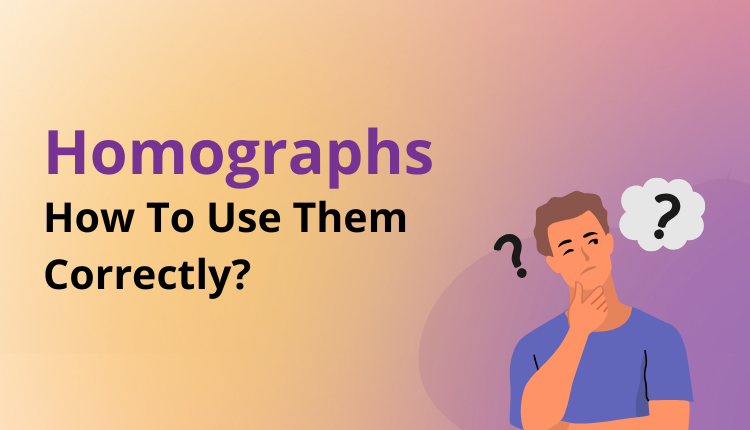Language can be a tricky playground, especially when it comes to words that look the same but carry different meanings. Enter homographs! These fascinating linguistic gems not only challenge our understanding of English but also add richness and depth to our communication.
Whether you’re a writer aiming for clarity or a student polishing your language skills, mastering homographs is essential. Let’s start with what they are, have a look at some fascinating examples, and see how to make the most of them in your writing. Buckle up; this ride is going to be illuminating!
What Is a Homograph?
Homographs are interesting words that are spelled the same but with different meanings. They indicate the intricacy of the English language, in which context becomes very important in interpreting.
For instance, take the term “lead.” It can either be a metal or to take someone in front. The pronunciation could also differ, creating even more mystery. Knowing homographs enhances your vocabulary and your communicative skills, making it a key principle for anyone learning English.
Definition of Homographs
Homographs are homographs that are spelled the same but have distinct meanings. They can be both pronounced similarly or differently, which contributes to their complexity and uniqueness of language.
For instance, “lead” is used to denote a metal or the action of leading someone. Such duality creates homographs as intriguing but problematic for writers and speakers because they are only effective when used correctly.
Examples of Homographs in English
Homographs can create delightful confusion in English. Take the word “lead.” It can refer to a type of metal or mean to guide someone. Context makes all the difference.
Another fascinating instance is “tear.” You can tear a sheet of paper, or you may cry a tear during a sad movie. These words reveal the extent to which pronunciation and meaning change radically depending on usage, causing wonder and at times amusement amongst language learners.
Common Homographs and Their Meanings
One of the most popular homographs is “lead.” As a verb, it is to guide or direct, but as a noun, it is a metal. Another one is “tear,” which can be to tear something apart or the liquid that comes from our eyes when we cry.
The term “row” can refer to either a line of items in sequence or a disagreement between individuals. Knowledge of these differences improves your writing and prevents misunderstandings.
How to Use Homographs Correctly
The correct use of homographs depends on context. Observe the context words and phrases so that you are expressing the intended meaning. For example, “lead” can mean to lead or to a metal. The sentence itself will typically suggest which meaning fits.
When you write, think about the sound of the word in your sentence. If in doubt, reword for clarity. Hearing your work read out loud can help catch potential misunderstandings with homographs, so that you can adapt accordingly for effective communication.
Homographs vs homonyms and homophones
Homophones, homonyms, and homographs tend to confuse people. Homographs are words that are spelled the same but have different meanings, e.g., “lead” (to guide) and “lead” (a metal). The similarity in spelling can catch even experienced writers out.
Homonyms, however, include both homographs and words that are pronounced the same but with different meanings. Homophones, in particular, are words that are pronounced similarly but with a difference in meaning or spelling, such as “pair” and “pear.” Being aware of these differences is important for effective communication.
Trinka grammar checker can prove to be a useful tool when dealing with the intricacies of homographs. It assists in finding and correcting usage mistakes, making your writing clear. This is particularly helpful for those words that sound the same but are different in meaning.
Trinka also provides contextual recommendations for you based on your writing approach. Through the close reading of sentences, it makes sure you pick the correct meaning of a homograph each time. With such assistance, you are able to increase accuracy as well as confidence in communication through writing.
Learning homographs enhances your language abilities. They bring richness and sophistication to communication, enabling playful shades of meaning. Mastering their use, you can enrich written and spoken language. Don’t avoid these fascinating words; welcome them to enrich your vocabulary!
FAQs
Homographs are interesting words that are the same spelling but with varying meanings. They even have varying pronunciations, making it more complicated to master language. Because of this exceptional feature, homographs are so interesting and in some cases hard to read or write. For example, take the term "lead." It might describe a metal or the act of leading someone. To navigate this subtlety is crucial in order to effectively communicate, because context usually decides which meaning takes precedence in dialogue or written communications.
Homophones are words that are pronounced the same but have different meanings and spellings. For instance, "to," "two," and "too" are typical homophones. They can usually be confusing to write because they are the same when said. Knowing homophones is important for clear communication. Substituting a wrong word can completely alter the meaning of a sentence. Therefore, it's crucial to understand how to distinguish between these tricky words while writing or speaking.
Homographs and homonyms can be easily mistaken, yet they differ from one another. Homographs are words that have the same spelling but potentially different meanings and pronunciations. For instance, "lead" (to lead) and "lead" (a metal). Homonyms, however, are words that sound the same or are spelled the same but have different meanings. An example is the word "bat," which can be a flying animal or an implement of sports equipment for playing baseball. Knowledge of these subtleties serves to improve the clarity of communication. Knowing whether you are working with a homograph or a homonym adds depth to your language and makes your writing more accurate.

